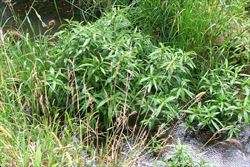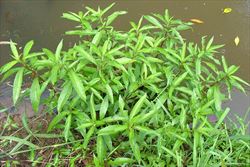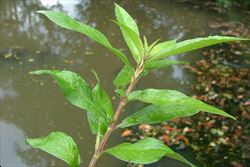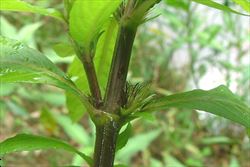Click on images to enlarge

infestation growing in a waterway (Photo: Sheldon Navie)

habit (Photo: Sheldon Navie)

habit (Photo: Sheldon Navie)

older stem rooting at the joints (Photo: Sheldon Navie)

younger four-angled stem with paired leaves (Photo: Sheldon Navie)

close-up of elongated leaves showing prominent midrib and veins (Photo: Sheldon Navie)

flowers in small clusters in the upper leaf forks (Photo: Sheldon Navie)

close-up of flowers and elongated bracts (Photo: Sheldon Navie)

close-up of immature fruit (Photo: Sheldon Navie)

seedlings and young plants (Photo: Sheldon Navie)
Scientific Name
Hygrophila costata Nees.
Synonyms
Hygrophila atricheta Bridar.Hygrophila brasiliensis (Spreng.) LindauHygrophila conferta NeesHygrophila guianensis NeesHygrophila hispida NeesHygrophila lacustris (Schltdl. & Cham.) NeesHygrophila longifolia NeesHygrophila portoricensis NeesHygrophila pubescens NeesHygrophila rivularis (Schltdl.) NeesHygrophila verticillata (Spreng.) Cabrera & G. DawsonRuellia brasiliensis Spreng.Ruellia lacustris Schltdl. & Cham.Ruellia rivularis Schltdl.Ruellia verticillata Spreng.
Family
Acanthaceae
Common Names
glush weed, gulf swampweed, hygrophila, lake hygrophila, sword leaf stricta, temple weed
Origin
This species is native to North America, Central America and South America (i.e. south-eastern USA, Mexico, Brazil, Ecuador, Argentina, etc.).
Cultivation
This species was deliberately introduced into Australia and cultivated as an aquarium plant, particularly in eastern Australia.
Naturalised Distribution
Hygrophila (Hygrophila costata) is becoming widely naturalised in eastern Australia. Currently, it is present in south-eastern Queensland and in the coastal districts of northern and central New South Wales.
Habitat
A weed of waterways, lakes, dams, ponds and wetlands in sub-tropical, tropical and warmer temperate regions.
Habit
An upright (i.e. erect) or spreading aquatic herbaceous plant with emergent stems usually growing up to 1 m tall, but occasionally reaching 1.5-2 m in height. It usually forms dense mats of floating vegetation around the edges of water bodies, but may occasionally be found in moist terrestrial locations.
Distinguishing Features
- an upright or spreading semi-aquatic herbaceous plant with emergent stems growing up to 1 m or more tall.
- its stems are usually somewhat four-angled and produce roots from their joints when they come in contact with the soil.
- is elongated leaves (3.5-18 cm long and 0.5-5 cm wide) are borne in pairs along the stems.
- small clusters of inconspicuous whitish flowers are borne in the leaf forks.
- these flowers (about 10 mm long) are stalkless and tubular in shape.
Stems and Leaves
The spreading stems often produce roots (i.e. adventitious roots) from their joints (i.e. nodes) when they come in contact with the soil. Younger stems are somewhat square in cross-section (i.e. quadrangular) and older stems can be quite robust.
The elongated leaves (3.5-18 cm long and 0.5-5 cm wide) are oppositely arranged along the stems and are either stalkless (i.e. sessile) or borne on stalks (i.e. petioles) up to 3.5 cm long. Their veins and midrib are quite prominent and they have sparsely hairy (i.e. pubescent) undersides. These leaves have entire or wavy (i.e. undulate) margins with pointed tips (i.e. acuminate apices) and gradually narrowed (i.e. attenuate) bases.
Flowers and Fruit
The inconspicuous, papery, and whitish-coloured flowers are borne in small clusters in the leaf forks (i.e. axils) along with several elongated green bracts (6-9 mm long and 1.5-3 mm wide). They are stalkless (i.e. sessile) and quickly turn brown after they open. These flowers (5.5-10 mm long) have petals that are fused together into a tube (i.e. a corolla tube), and are divided into two 'lips' near their tips. The upper 'lip' of the flower is two-lobed, while the lower 'lip' is three-lobed. The flowers also have five narrow green sepals (5-12 mm long), four stamens and an ovary topped with a style and stigma.
The fruit is a small spindle-shaped capsule (7-13 mm long) containing numerous tiny seeds. These seeds are pale brown in colour, round (about 0.3 mm across), flattened and become sticky when wet.
Reproduction and Dispersal
This species reproduces via both seeds and stem fragments.
Most spread of the seeds and stem fragments is by water movement or with the assistance of watercraft. The sticky seeds may also be spread by birds and other animals or by vehicles. Stem fragments have also be dispersed to new areas in dumped aquarium waste.
Environmental Impact
Hygrophila (Hygrophila costata) is regarded as an environmental weed in Queensland and New South Wales and is listed as a priority environmental weed in at least one Natural Resource Management region. This species is a significant weed in shallow aquatic habitats in north-eastern New South Wales and south-eastern Queensland. It thrives in and around the margins of freshwater lakes and slow moving streams, where it spreads rapidly and forms dense mats of vegetation. In fact, hygrophila (Hygrophila costata) often forms dense such stands that it displaces most other plant species in invaded aquatic and wetland habitats. Once the native flora has been displaced, and the habitat changed, native animals may also be displaced from invaded areas.
Hygrophila (Hygrophila costata) was recently ranked among the top 20 most invasive plant species in the south-east Queensland region. It is a particularly serious problem in Lake McDonald, near Cooroy, and along the Caboolture River near Caboolture. At Lake McDonald, there is a single infestation of this species covering over 50% of the lake's perimeter, with an estimated area of 73 hectares. Hygrophila (Hygrophila costata) and has also been recorded from several other areas in south-eastern Queensland, including suburban Brisbane, Beaudesert, Maryborough, Beenleigh and the Gold Coast.
In New South Wales this species has become naturalised in various coastal locations on the North Coast, including in a wetland near Casino, along Byron Creek downstream of Bangalow and along Burringbar Creek at Mooball. On the Central Coast, where it is an emerging problem, infestations have been found in the Maitland area and at Raymond Terrace near Port Stephens.
Hygrophila (Hygrophila costata) is thought to degrade riparian zones by reducing stream flows and altering the natural flow patterns of rivers, streams and wetlands. It is also regarded as a principal weed species affecting freshwater wetlands on coastal floodplains in New South Wales, an ecological community that is listed as endangered in this state.
Legislation
This species is declared under legislation in the following states and territories:
- New South Wales: Class 2 - a regionally prohibited weed. The presence of the weed must be notified to the local control authority and it must be eradicated from the land and the land must be kept free of the plant (in a large number of local authority areas). See the New South Wales Department of Primary Industries Noxious Weeds List at http://www.dpi.nsw.gov.au for more detailed information on which local areas are covered in these declarations.
- Queensland: Class 1 - introduction into the state is prohibited, and landowners must take reasonable steps to keep land free of this species (throughout the entire state). It is also illegal to sell a declared plant or its seed in this state.
- Western Australia: Unassessed - on the prohibited species list and not permitted entry into the state.
Management
For information on the management of this species see the following resources:
- the New South Wales Department of Primary Industries Weed Alert on this species, which is available online at http://www.dpi.nsw.gov.au.
- the Port Stephens Council Weed Information Sheet on this species, which is available online at http://www.portstephens.nsw.gov.au.
Similar Species
Hygrophila (Hygrophila costata) may be confused with a similar native species (Hygrophila angustifolia). It is also relatively similar to Senegal tea plant (Gymnocoronis spilanthoides) when not in flower. These species can be distinguished by the following differences:
- hygrophila (Hygrophila costata) is a relatively large plant (sometimes growing 1-2 m tall) and has stems that are not hollow. Its leaves are relatively narrow (up to 18 cm long and 5 cm wide) and have entire margins. Its flowers are tubular in shape (5.5-10 mm long), stalkless (i.e. sessile), and borne in small clusters in the leaf forks (i.e. axils). These flowers are usually whitish in colour and the mature fruiting capsules are relatively small (7-13 mm long).
- Hygrophila angustifolia is a relatively small plant (usually growing 15-45 cm tall) and has stems that are not hollow. Its leaves are very narrow (usually 2.5-16 cm long and only 2-8 mm wide) and have entire margins. Its flowers are tubular in shape (9-20 mm long), stalkless (i.e. sessile), and borne in small clusters in the leaf forks (i.e. axils). These flowers are either white with darker markings, violet, blue or mauve in colour and the mature fruiting capsules are relatively large (10-18 mm long).
- Senegal tea plant (Gymnocoronis spilanthoides) is a relatively large plant (growing 1-2.5 m tall) and has somewhat hollow stems. Its leaves are relatively narrow (5-20 cm long and 25-50 mm wide) and have finely toothed (i.e. serrated) margins. Its flower-heads (i.e. capitula) are fluffy in appearance (15-20 mm across) and borne in small stalked clusters at the tips of the branches. These flowers are white or pale purplish in colour and the mature fruit are small achenes.
It may also be confused with Australian water horehound (Lycopus australis). However, this native species has smaller flowers (4.5-5.5 mm long) and leaves with coarsely toothed (i.e. serrated) margins.

